St Peter's Hospital
27 Henrietta Street, Covent Garden, WC1
Medical dates:
Medical character:
Specialist
During the mid 19th century
there had been a great increase in the prevalence of stones in the
urinary system, the number of deaths from stone or other renal diseases
doubling between the years 1850-1860. It had once been thought
that the cause of such stones was due to over-eating, but it seems that
the exact opposite was the case, as the affliction was always more
common in those with dietary deficiency, and improved when the diet
improved.
In 1860 a meeting was held at the home of the surgeon Mr Armstrong Todd in Burlington Street to discuss the lack of a specialist hospital for bladder stones and other urological diseases. Also present were another surgeon, Mr Spencer Wells, Mr TP Oldershaw (who later became the Treasurer) and the Revd AB Whatton (who became the Secretary).
A house was procured at 42 Great Marylebone Street* for the Hospital for Stone and Diseases of the Urinary Organs. It was the first hospital to specialise in the removal of bladder stones, replacing lithotomy (removal by open operation, which had a considerable mortality rate) with newer methods of crushing or dissolving the stones (lithotrity). Work at the Hospital began in a modest way (there can have been few, if any, beds), but soon patients were attending in large numbers.
Founded much later than other specialist Hospitals (32 had been established by this time), the Hospital for Stone drew the most wrath and passion from those in the medical profession who objected to specialist hospitals. Since 1853 the British Medical Journal and The Lancet had campaigned aggressively against the need for such hospitals, finding much support from senior physicians and surgeons on the staff of general voluntary hospitals. Specialist hospitals were regarded as attempts to cash in on the credulity of the public and to divert charitable donations away from more laudable institutions to ill-conceived ventures established for the aggrandizement of their founders. Furthermore, teaching hospitals were losing much of their clinical teaching material. The Hospital for Stone was described as 'especially unnecessary'.
It soon became apparent to the Hospital Management Committee that better and larger accommodation was necessary. In 1863 a large house was leased at 54 Berners Street, 'under the very shadow of the Middlesex Hospital'. The premises were large enough to accommodate 15 beds. The name of the Hospital was changed to St Peter's Hospital for Stone (the 'other urinary diseases' in its former title was dropped, being deemed as a euphemism for venereal disease at this time). The average stay in Hospital was 100 days and the mortality rate following lithotrity (crushing the stone) was 15.2%.
On 11th February 1873 a stranger presented a sealed packet to the Hospital Secretary. Asking for a receipt, he stipulated that the packet should not be opened until he had left the building. The paclet contained ten £1000 notes (yes, £1000 notes!). No stipulations were made as to how the money should be spent. The British Medical Journal could not resist having a go: "the ill-advised munificence which endows it only tends to perpetuate an evil which might otherwise have been expected to die out with those who promoted it."
The Management Committee began to look for more suitable premises and found a site in Henrietta Street, Covent Garden. The newly purpose-built Hospital was opened in 1882 by Prince Leopold, Duke of Albany. The site and building had cost £13,923 and the furnishing and other expenses £1598 - a total of £15,521.
The Hospital gradually built up a reputation for the successful removal of bladder stones, using litholapaxy (crushing the stone completely and evacuating the debris from the bladder). The mortality rate for this procedure (with antisepsis) was 2.2% during 1915-1924, with patients remaining in Hospital for only five days.
In 1900 the first suprapubic prostatectomy at the Hospital was carried out by Mr Peter Freyer, thereafter changing the emphasis of the surgical work performed there from the treatment of calculous disease to surgery for prostatic obstruction.
During WW1 the Hospital came under the Eastern Command, when some 12 beds were reserved for wounded servicemen.
In 1918 an elderly man, admitted for a prostatectomy, asked to see the Hospital Secretary. He explained that he had been the bearer of the anonymous gift 45 years ago on behalf of the donor. The donor had since died, but his name was confided to the Secretary. At a secret meeting the Committee of Management decided that, since the donor did not wish his name to be known in his lifetime, it should not be published. No note was made of the lengthy discussion in the Minute book and thus the 'Friend of the Hospital' remains anonymous forever.
After WW1 demand for bed space increased, and the shops on the ground floor of the building, which had been rented out, were gradually taken over. By 1930 the Hospital occupied the whole site; the ground floor became the Out-Patients Department. An X-ray Department and offices occupied the other available space. A house was acquired on the opposite side of Henrietta Street (there being no possibility of further expansion on the Hospital side). This building, No. 10 Henrietta Street, became the pathology laboratory, a museum and a Nurses' Home (later in 1954 it became the Institute of Urology).
During WW2 the Hospital was closed, as were St Paul's Hospital and the Hospital for Women in Soho Square, due to lack of medical and nursing staff who had been called to active service.
In 1948, under the control of the NHS, St Peter's and St Paul's Hospitals were amalgamated into a postgraduate teaching hospital group. St Philip's Hospital joined the group in 1952, when it became known locally as 'The Three Ps'. The Shaftesbury Hospital joined the group in 1967.
St Peter's Hospital, with 41 beds, closed in 1992, as did the other Hospitals in the St Peter's Group. Services moved to the Middlesex Hospital.
In 1860 a meeting was held at the home of the surgeon Mr Armstrong Todd in Burlington Street to discuss the lack of a specialist hospital for bladder stones and other urological diseases. Also present were another surgeon, Mr Spencer Wells, Mr TP Oldershaw (who later became the Treasurer) and the Revd AB Whatton (who became the Secretary).
A house was procured at 42 Great Marylebone Street* for the Hospital for Stone and Diseases of the Urinary Organs. It was the first hospital to specialise in the removal of bladder stones, replacing lithotomy (removal by open operation, which had a considerable mortality rate) with newer methods of crushing or dissolving the stones (lithotrity). Work at the Hospital began in a modest way (there can have been few, if any, beds), but soon patients were attending in large numbers.
Founded much later than other specialist Hospitals (32 had been established by this time), the Hospital for Stone drew the most wrath and passion from those in the medical profession who objected to specialist hospitals. Since 1853 the British Medical Journal and The Lancet had campaigned aggressively against the need for such hospitals, finding much support from senior physicians and surgeons on the staff of general voluntary hospitals. Specialist hospitals were regarded as attempts to cash in on the credulity of the public and to divert charitable donations away from more laudable institutions to ill-conceived ventures established for the aggrandizement of their founders. Furthermore, teaching hospitals were losing much of their clinical teaching material. The Hospital for Stone was described as 'especially unnecessary'.
It soon became apparent to the Hospital Management Committee that better and larger accommodation was necessary. In 1863 a large house was leased at 54 Berners Street, 'under the very shadow of the Middlesex Hospital'. The premises were large enough to accommodate 15 beds. The name of the Hospital was changed to St Peter's Hospital for Stone (the 'other urinary diseases' in its former title was dropped, being deemed as a euphemism for venereal disease at this time). The average stay in Hospital was 100 days and the mortality rate following lithotrity (crushing the stone) was 15.2%.
On 11th February 1873 a stranger presented a sealed packet to the Hospital Secretary. Asking for a receipt, he stipulated that the packet should not be opened until he had left the building. The paclet contained ten £1000 notes (yes, £1000 notes!). No stipulations were made as to how the money should be spent. The British Medical Journal could not resist having a go: "the ill-advised munificence which endows it only tends to perpetuate an evil which might otherwise have been expected to die out with those who promoted it."
The Management Committee began to look for more suitable premises and found a site in Henrietta Street, Covent Garden. The newly purpose-built Hospital was opened in 1882 by Prince Leopold, Duke of Albany. The site and building had cost £13,923 and the furnishing and other expenses £1598 - a total of £15,521.
The Hospital gradually built up a reputation for the successful removal of bladder stones, using litholapaxy (crushing the stone completely and evacuating the debris from the bladder). The mortality rate for this procedure (with antisepsis) was 2.2% during 1915-1924, with patients remaining in Hospital for only five days.
In 1900 the first suprapubic prostatectomy at the Hospital was carried out by Mr Peter Freyer, thereafter changing the emphasis of the surgical work performed there from the treatment of calculous disease to surgery for prostatic obstruction.
During WW1 the Hospital came under the Eastern Command, when some 12 beds were reserved for wounded servicemen.
In 1918 an elderly man, admitted for a prostatectomy, asked to see the Hospital Secretary. He explained that he had been the bearer of the anonymous gift 45 years ago on behalf of the donor. The donor had since died, but his name was confided to the Secretary. At a secret meeting the Committee of Management decided that, since the donor did not wish his name to be known in his lifetime, it should not be published. No note was made of the lengthy discussion in the Minute book and thus the 'Friend of the Hospital' remains anonymous forever.
After WW1 demand for bed space increased, and the shops on the ground floor of the building, which had been rented out, were gradually taken over. By 1930 the Hospital occupied the whole site; the ground floor became the Out-Patients Department. An X-ray Department and offices occupied the other available space. A house was acquired on the opposite side of Henrietta Street (there being no possibility of further expansion on the Hospital side). This building, No. 10 Henrietta Street, became the pathology laboratory, a museum and a Nurses' Home (later in 1954 it became the Institute of Urology).
During WW2 the Hospital was closed, as were St Paul's Hospital and the Hospital for Women in Soho Square, due to lack of medical and nursing staff who had been called to active service.
In 1948, under the control of the NHS, St Peter's and St Paul's Hospitals were amalgamated into a postgraduate teaching hospital group. St Philip's Hospital joined the group in 1952, when it became known locally as 'The Three Ps'. The Shaftesbury Hospital joined the group in 1967.
St Peter's Hospital, with 41 beds, closed in 1992, as did the other Hospitals in the St Peter's Group. Services moved to the Middlesex Hospital.
Present status (December 2007)
The Grade II building has been converted to seven large apartments.
£1000 notes were withdrawn in 1943.
In 2009 the gift of £10,000 would be worth nearly £700,000 in prices, or £5,600,000 in earnings.
(www.measuringworth.com)
* Great Marylebone Street was abolished in 1904 and incorporated into New Cavendish Street. No. 42 Great Marylebone Street became No. 59 New Cavendish Street. In 1937 Upper Marylebone Street was incorporated into New Cavendish Street and the properties renumbered yet again. No. 59 New Cavendish Street became No. 34 New Cavendish Street.
£1000 notes were withdrawn in 1943.
In 2009 the gift of £10,000 would be worth nearly £700,000 in prices, or £5,600,000 in earnings.
(www.measuringworth.com)
* Great Marylebone Street was abolished in 1904 and incorporated into New Cavendish Street. No. 42 Great Marylebone Street became No. 59 New Cavendish Street. In 1937 Upper Marylebone Street was incorporated into New Cavendish Street and the properties renumbered yet again. No. 59 New Cavendish Street became No. 34 New Cavendish Street.
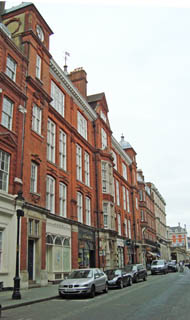
The former Hospital - the building in Henrietta Street - as seen from the west.
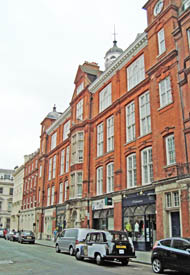
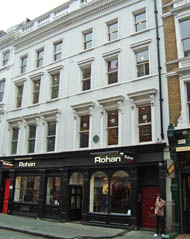
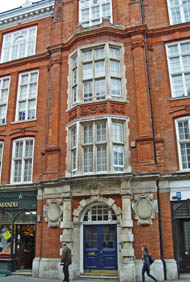
The front entrance of the building.
The Hospital building seen from the east. The ground floor has reverted to shop fronts.
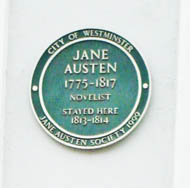
No. 10 Henrietta Street, on the opposite side of the road, bears a plaque to Jane Austen.
Black N 2006 Walking London's Medical History. London, Royal Society of Medicine Press.
Dukes CE 1957 The history of St Peter's Hospital for Stone. Proceedings of the Royal Society of Medicine 50, 161-164.
Morson C (ed) 1960 St Peter's Hospital for Stone 1860-1960. Edinburgh & London, E&S Livingstone.
Williams DI 1994 Acrimony and the origin of St Peter's. Journal of the Royal Society of Medicine 87, 164-168.
http://apps.nationalarchives.gov.uk
http://archiseek.com
http://collage.cityoflondon.gov.uk
http://list.english-heritage.org.uk
http://wellcomeimages.org
www.baus.org.uk
www.british-history.ac.uk
www.coventgardentrust.org.uk
www.flickr.com
www.instituteofurology.org
www.uclh.nhs.uk
Return to home page